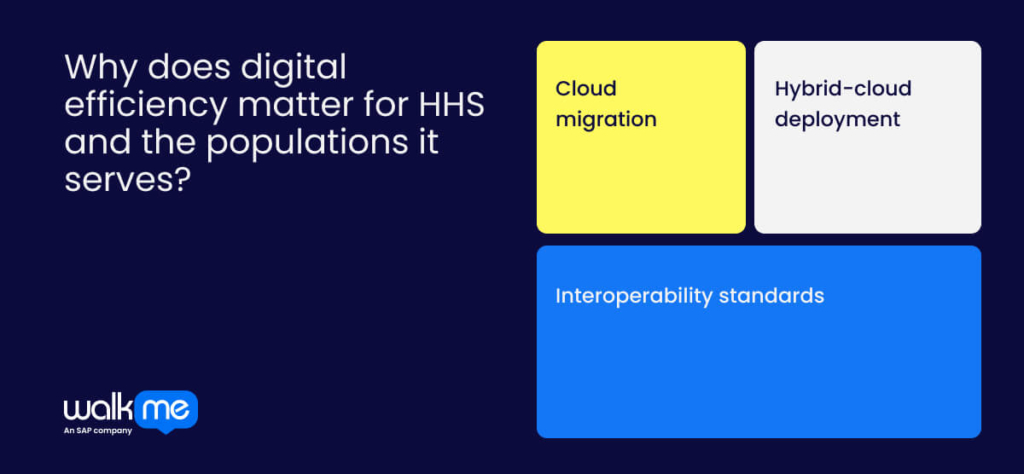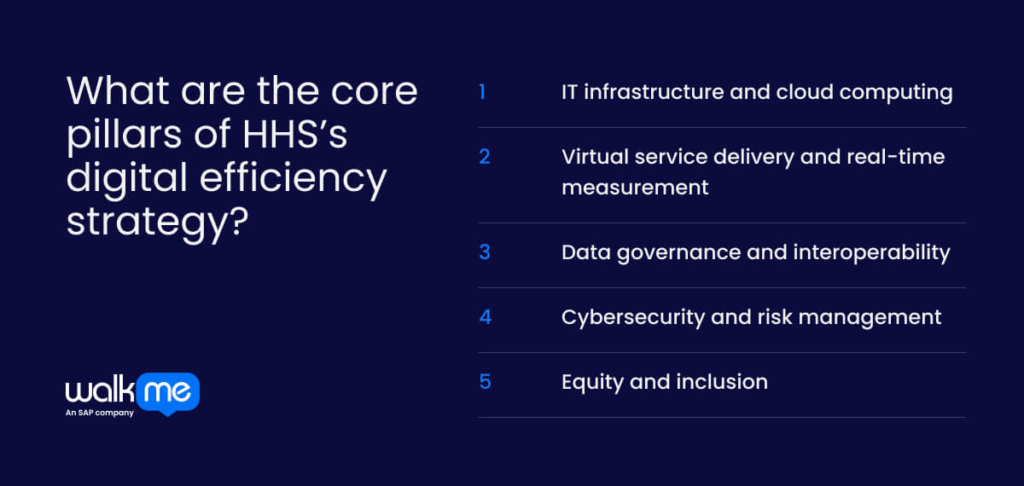The Department of Health and Human Services (HHS) oversees public health, medical research, and social services, impacting billions of Americans every year.
With such scale, digital efficiency is crucial for delivering timely support. Significant strides include the HHS AI Strategic Plan and its alignment with the Digital Government Strategy, which promotes data sharing across agencies. These efforts help modernize legacy systems, reduce manual handoffs, and improve service delivery.
HHS tracks over 900 performance metrics for efficiency and service outcomes. Adopting cloud ecosystems, automating administrative tasks, and building digital literacy demonstrate how the department is transforming its operations.
Moving forward, continued investment in interoperability and human-centered design will ensure that HHS keeps pace with public needs and remains digitally adept. This article explores digital efficiency in the U.S. Department of Health and Human Services.
What is digital efficiency in the Department of Health and Human Services?
Digital efficiency at HHS means replacing outdated systems with faster, more connected digital tools that improve services and reduce costs.
Under its Data Center Optimization Plan, HHS has moved many systems to the cloud, cutting expenses and making operations more flexible. Following its Digital Government Strategy, HHS now shares over 400 datasets on HealthData.gov, with 35 available through APIs.
These are examples of digital efficiency changes that help teams spend less time on manual tasks and more time serving the public.
In most cases, this means significantly faster digital processes and measurable cost savings, benefiting both internal stakeholders and the American public. More importantly, HHS must remain at the forefront of technology-driven innovation to ensure its services are agile, equitable, and ready to meet the needs of a modern population.
Why does digital efficiency matter for HHS and the populations it serves?

Digital efficiency is important for HHS because it determines how quickly and accurately the department can serve the public. This is especially true during emergencies, routine health services, and administrative processes.
It’s best to give three concrete examples to show you why digital efficiency is particularly important for HHS:
Cloud migration
Cloud migration has allowed HHS to modernize its infrastructure at scale. By FY 2022, the department had closed 49 data centers, resulting in over $18.5 million in operational cost savings. These savings free up resources for frontline services, improving system responsiveness during crises.
Hybrid-cloud deployment
The HHS Office of Inspector General cut IT costs by 33% through hybrid-cloud deployment, launching 50 digital tools to streamline audits and oversight. This enhances fraud detection and accountability, protecting both taxpayer dollars and patient programs.
Interoperability standards
The adoption of FHIR interoperability standards supports real-time data sharing between providers and systems. That means fewer repeated tests, faster treatment decisions, and a more connected care experience for patients.
How is HHS delivering digital efficiency across health and human services?
Understanding how HHS delivers digital efficiency reveals how public health, safety nets, and service delivery are being modernized. The primary goal of HHS in this regard is to ensure faster response times, better care coordination, and more efficient use of taxpayer resources.
Let’s take a closer look at how the HHS delivers digital efficiency across health and human services:
Modernizing legacy systems
Outdated technology can slow down services and cost a lot more to maintain. HHS is addressing this issue by transitioning to cloud platforms, such as Salesforce and AWS GovCloud. This change reduces costs and makes data more accessible to the entire team. Faster, more reliable systems enable staff to respond quickly and deliver better care. IT modernization also creates a strong base that supports smooth, transparent health services for all Americans.
Implementing virtual human services
HHS is making services easier to reach through digital tools like telehealth and virtual case management. These options reduce wait times and help people who are unable to visit offices in person. Apps simplify the process of signing up for benefits like Medicaid, and virtual assistants can answer common questions. By going digital, HHS ensures staff focus on personal support, making help more convenient and fair for all.
Enhancing data management with AI
AI helps HHS turn large amounts of data into useful information. It speeds up fraud detection, claim processing, and health record analysis. Machine learning (ML) spots billing errors, while natural language processing pulls important facts from complex text. AI data management helps HHS make better decisions and use resources wisely, improving health programs for communities nationwide.
Secure by design” principles
At HHS, security starts early and is part of every technology project. Using zero-trust systems, encrypted data, and constant monitoring, the department protects sensitive health information. Security checks during development catch problems before they happen. This careful approach helps avert AI security risks, builds trust, and ensures that public health services remain reliable as technology evolves.
Coordinated executive leadership
Clear teamwork guides HHS’s digital progress. The Chief Information Officer works closely with agency leaders to set goals and prevent duplicated efforts. Tools like the FITARA dashboard measure progress and spotlight needs. Programs like ReImagine HHS promote collaboration and shared responsibility. This focused leadership keeps digital updates well-planned, funded, and aligned with the goal of better health services.
What are the core pillars of HHS’s digital efficiency strategy?

Now that you’ve explored how HHS delivers digital efficiency across health and human services, it’s time to dive into the core pillars of its digital strategy. Let’s take a closer look at the core pillars of HHS’s digital efficiency strategy:
IT infrastructure and cloud computing
HHS is modernizing its technology by moving to cloud-based platforms like AWS GovCloud and Salesforce. This shift replaces outdated systems with faster, more flexible infrastructure that scales easily and reduces costs. Cloud-based collaboration solutions also improve data sharing across departments, allowing teams to work better together. As a result, staff can focus more on public service and less on resolving tech problems. This foundation speeds up innovation and supports more efficient, connected healthcare delivery.
Virtual service delivery and real-time measurement
HHS is redesigning how people access services by introducing enterprise portals, chatbot support, and mobile-first applications. These tools reduce paperwork delays and give users instant updates on application status, service eligibility, or appointment availability. Real-time measurement dashboards track system performance, enabling teams to identify and resolve issues before they escalate.
Data governance and interoperability
Data governance at HHS is more than policy and represents how decisions become data-driven. Interoperability standards ensure systems can exchange information reliably, giving leaders a unified view across programs. This improves coordination, prevents duplication, and reduces errors. Privacy protections are also built in, not added later, building public trust with every use.
Cybersecurity and risk management
To protect sensitive health information, HHS follows a layered approach to cybersecurity. From day one, systems are designed with security in mind, using encryption, zero-trust access, and real-time monitoring. Risk plans enable teams to act quickly if a threat is detected. These steps ensure that public data remains safe, meets federal security requirements, and provides people with confidence in using HHS digital services.
Equity and inclusion
HHS is working to make sure digital tools work for everyone. That means designing services that are easy to use, available in multiple languages, and accessible across all devices. Outreach is tailored to reach underserved communities, and with the implementation of AI across government programs, the department can better identify service gaps and ensure equitable access to critical resources in real time.
How is HHS addressing challenges in virtual service delivery and data management?
Understanding the core principles behind HHS’s digital efficiency strategy will give you the clarity needed to navigate this section with purpose. Challenges in virtual service delivery and data management continue to limit scalability and equity across programs. However, these can be addressed with the right digital frameworks.
Let’s take a closer look at how HHS is addressing challenges in virtual service delivery and data management:
Tackling digital divides and technology access inequities
HHS is working to close digital gaps by offering services on mobile devices, providing support in many languages, and partnering with local groups to expand access. These changes help people who may not have access to the internet, devices, or technical skills. The ultimate goal is to ensure that no one is left out and that every individual can access the services they need with ease and confidence.
Adapting data collection tools
To make better decisions, HHS is improving how it collects data. Forms now use clearer language and offer different ways to respond, including anonymous options. These updates help include more people, especially those often missed, and ensure that programs are based on real needs, not guesswork.
Initial exploratory assessments
Before launching new tools, HHS tests how well they work for different users. These early checks help identify problems, such as hard-to-read screens or unclear instructions. Fixing these issues prematurely means that services will be more useful, fair, and easier to access once they’re fully rolled out.
How does HHS build trust through transparency, accountability, and performance?
To fully understand how digital efficiency works in practice, it’s essential to look at the values that guide it. This section breaks down how HHS builds public trust through transparency, accountability, and performance.
Let’s take a closer look at how HHS builds trust through transparency, accountability, and performance:
Tracking progress with FITARA and program evaluations
HHS uses tools like FITARA and regular program reviews to check how well digital systems are working. These reports highlight what’s going right and where improvements are needed. Tracking progress openly means the agency demonstrates its seriousness about results, which helps earn long-term public confidence.
Publishing performance metrics and cyber goals
HHS shares clear data on how systems perform and what’s being done to keep information secure. When people can see the goals and how close they are to being met, it creates trust. It indicates the department is accountable and working toward real, measurable improvements, not vague plans.
Gathering feedback through open data and engagement
Instead of guessing what works, HHS listens directly to the public using surveys, public comment tools, and open data platforms. This input helps shape decisions and makes people feel heard. When communities see their voices reflected in services, it builds trust through transparency and shared responsibility.
What trends will shape the digital efficiency of HHS over the next decade?
HHS is a vast and complex organization with many interconnected parts working simultaneously. When considering digital efficiency within HHS, it’s crucial to keep this complexity in mind. For example, the strides made in streamlining claims processing have resulted in notable efficiency improvements, reducing wait times and administrative costs.
However, these gains raise an important question. Are current efficiency gains sufficient to meet future demands? As technology evolves, HHS must continue to innovate to maintain its edge. Over the next decade, AI will become integral across multiple HHS functions, from data analysis to service delivery.
Staying ahead means balancing innovation with rigorous oversight to ensure value for money, protect privacy and security, and deliver meaningful improvements that serve the public.
FAQs
Digital efficiency means HHS uses technology to speed up and simplify how it delivers services. This reduces paperwork, cuts wait times, and helps staff focus on what matters most. It also makes programs easier to access and manage, ensuring faster support and better results for everyone who relies on HHS.
HHS uses data and new technologies to make virtual services more responsive and personalized. Analyzing real-time information, they can better understand people’s needs, spot problems early, and tailor support. This approach helps deliver services that are quicker, fairer, and easier to access, especially for those facing barriers.
HHS is restructuring to promote teamwork across departments and reduce silos. It invests in employee training, updates policies for digital tools, and creates leadership roles focused on innovation. These changes enable the department to adopt technology faster and deliver improved, efficient services.

